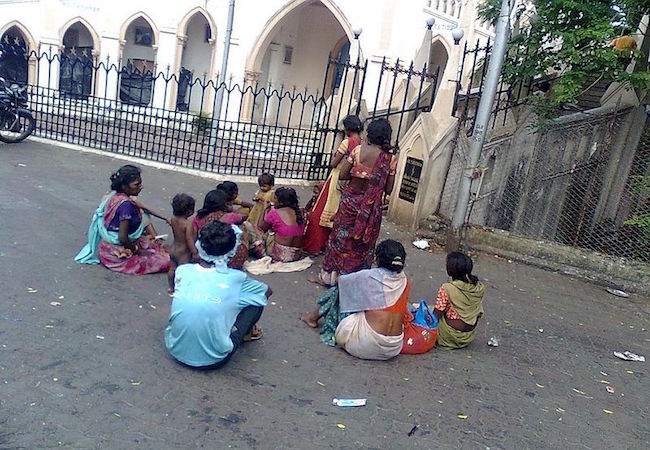
By Harshit Pai
I live in India, a place which is ranked 100 out of 119 countries in the Global Hunger Index (GHI). We have 190.7 million undernourished people which means that we house 23.4% of the world’s hungry. Although there are many country specific reasons for the growing hunger in India like decreased production due to drought, logistical mismanagement of ration distribution and bad food policies, there is one global reason why the world’s poor are going hungry. This little known reason is called financilization of the food market or what I like to call ‘Financing Hunger’.
Financialization, by definition, refers to the size of the country’s financial sector relative to its overall economy. Financialization of food refers to the involvement of the financial sector in the food industry. This means that commodities like food grains are traded on the financial markets like we would trade shares. Like many of the innovations that came with capitalism, financialization of the food market has brought forth many advantages to the sector. However, like all things common with capitalism, lack of regulation has done more harm than good.
Futures contracts and index funds
Financialization of food is achieved through something called ‘futures contracts’. This is how a futures contracts works: suppose you are a farmer wanting to sell your harvest, traditionally you would’ve gone to the local market and sold your grains at the price the merchant was willing to buy after some negotiation. However, this came with its own risks, sometimes the merchant would not be willing to buy your grains or offer you a price that is lower than your costs of growing that product. Similarly, suppose you are a merchant who buys food grains from the local market, this method again came with similar risks, the harvest might be of poor quality, or the drought made the availability of the grain scarce.
The futures markets solves these problems by fixing the price and quantity of the food grains to be delivered at a future date. Suppose you are a farmer who is not sure what price you would get in the local market at the time of the harvest. You would go to the Mercantile Exchange and fix a price by selling a futures contract for your harvest. An investor at the mercantile exchange would buy that futures contract and later sell it when there are buyers of the food grain. This creates liquidity in the market and prevents the seller and buyer of the food grains from risks of price fluctuation or bad harvest.
Although, this innovation was meant to provide liquidity and allow the buyers and sellers to hedge their risks in this volatile market, the loosening up of regulation is causing big investors to exploit them. One way this exploitation is being practiced is through Commodity Index Funds (CIFs). Index funds are financial instruments that track the price fluctuation of the indexed markets. So, if you invest in a CIF that money would be invested in commodity futures contract like agriculture. You would get returns based on the change in the prices of the futures contracts. What’s interesting is that these index funds are sold by investment banks and they are the ones who directly buy or sell futures contracts on your behalf.
So, instead of the liquidity that traditional speculators provided by buying futures contracts to sell them later to a buyer of the food grains. The index fund speculators buy large amounts of futures contracts and then sell them before the maturity and invest the returns in other futures contract. This leads them to invest in large number of futures contracts that are spread across the calendar spread, blocking liquidity and providing no benefit to the sector. The index fund speculators, then, become the largest buyers of the futures contract leaving little contracts for traditional speculators and actual traders. It has been seen that since 2003, commodity index speculation has increased from $13 billion to $260 billion in 2008. Moreover, unlike traditional speculators who sell the futures contract to willing buyers later, the index fund speculators hoard these contracts which leads to “virtual hoarding”, raising the price of food grains in the process.
How did we get here?
So how did this boon for the agricultural industry become the cause for its bane? Large and smart investors usually create a portfolio with a combination of different types of investment options. They seek to create the perfect combination of assets which would give them the highest returns with the least amount of risk. To achieve this they have a combination of extremely risky investment options which provide high returns along with investments which are less risky but provide lower returns. The reason commodities like food grains became famous among investors is because it tends to move in the opposite direction to shares and bonds. So, if shares and bond prices go down, commodity prices tend to go up. Hence, investors started investing in them to minimise the risk of their portfolio.
People started heavily investing in the commodities market after the 2008 financial crisis. The steep fall in the share prices motivated many investors to invest in the commodities market to dampen their losses. Moreover, this market was seen as a safer option because food grains continuously reap harvest, something that investors call “commodities super cycle”.
Also, unlike normal stock market, investors in the commodity market can trade based on the inside information. This puts big institutions at an advantage who, as I mentioned earlier, don’t buy futures contracts for future delivery of the product, putting the actual traders at a great disadvantage.
Moreover, a report by the United Nations Conference on Trade and Development explained that investors usually act in a herd like fashion and tend to buy investment options that other people are buying. This means that as more and more people buy Commodity Index Funds, others follow them, raising the price of the food grains further.
Where are we headed?
The World Bank in its 2010 report stated that the rising food prices have driven an additional 44 million people into poverty and a large part of it is due to the financialization of the agricultural market. In fact, there seems to be a pattern of boom and fall when it comes to financializing markets. It is seen that as each market bubble burst, large institutional investors move to other markets that they consider safe, before long even that market crashes. It happened with the dot com bubble followed by the mortgage bubble and now the food price hikes.
Moreover, in markets like agriculture, both the rise and fall of prices affects people adversely. The rise in the price of food grains makes it hard on the consumers and the fall in prices affects the farmers. The increase in the food price is already affecting developing countries whose poor spend the majority of their income on food. It is also adversely affecting the countries who rely heavily on food imports and suffer due to the fluctuation of the world food market.
The financialization is not just affecting the prices of food but it is also grabbing land from the poor. Large investors who sell CIF are buying large areas of land to hedge themselves against the risk of the volatile markets, forcing farmers into poverty by leaving them landless.
Capitalism is not all bad and as I have mentioned it has brought forth great innovations that have made different industries much more efficient. However, a lack of regulation in these countries is allowing certain people to misuse their great financial strength into making themselves richer while the majority of the world starves. I want to see my country fed but if these prices continue to rise even the best government can’t feed the hungry.
References
- Moore, J. W. (2010). Cheap Food & Bad Money. Review: A Journal of the Fernand Braudel Centre, 33(2–3), 225–261.
- FAO. (2011). Global Food Price Monitor, 46(22), 20–21.
- Chowdhury, A. (2011). Food Price Hikes: How Much Is Due to Excessive Speculation? Economic & Political Weekly, XLVI(28), 12–15.
- Clapp, J. (2012). The Financialization of Food : Who is Being Fed ? International Society for Ecological Economics Conference, 1–23.
Harshit Pai is a Master’s student at OP Jindal Global University




